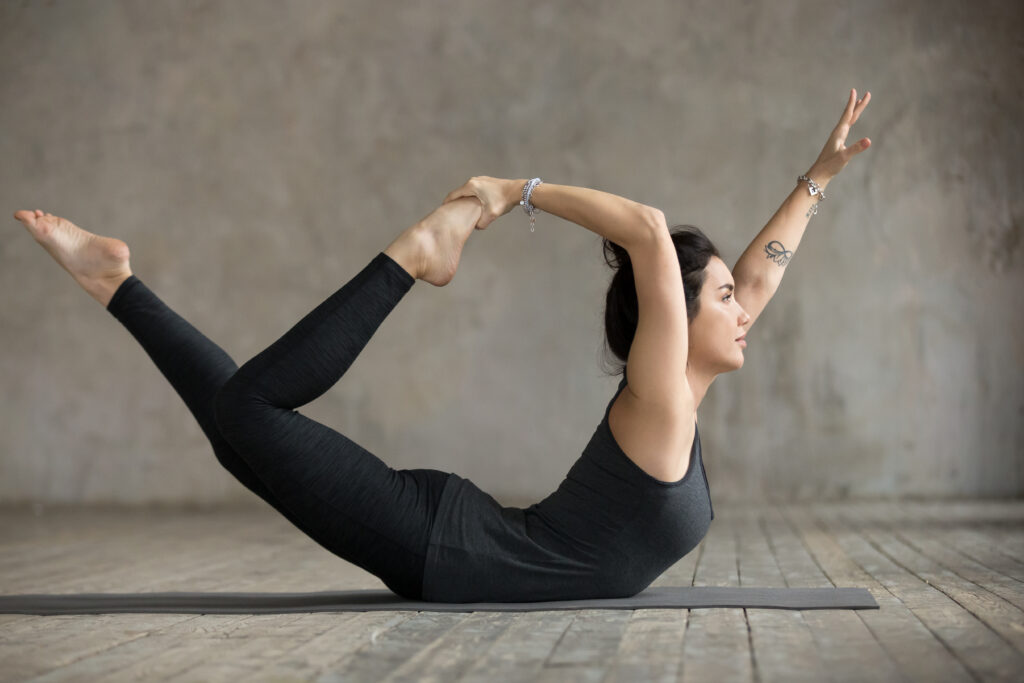Flexibility is often a forgotten hero in the world of sports, where speed, agility, and precision rule supreme. The ability to bend, stretch, and move with grace can make all the difference between an athlete’s success and setbacks. We’ll explore the field of flexibility-enhancing exercises in this comprehensive guide, discover the science behind them, find out what advantages they bring and develop practical strategies to incorporate them into your sporting life.
The Role of Flexibility in Sports Performance
The silent force behind breathtaking dives, gravity-defying leaps, and lightning-quick changes of direction is Flexibility, the unsung sports hero. This goes beyond bending your body, it’s the key to giving you complete athletic potential. Why is it important for athletes to spend time on flexibility training? More than impressive high kicks or gravity-defying splits, the benefits extend far beyond these. They include prevention of injuries, greater range of motion, reduction in muscle soreness, better posture, more balance and longevity on the playing field.
Basics
Flexibility doesn’t have to be one size fits all. This includes many components, which influence how your body is moving. You will explore the distinction between static and dynamic, as well as how both are different in terms of mobility.
Static vs. Dynamic
The ability to keep your stretch in a fixed position is known as static flexibility. In contrast, dynamic flexibility requires active movement that takes the muscles and joints to a full range of motion. They are essential, but in the sports world, they differ from one another.
Flexibility vs. Mobility: Key Differences
While mobility and flexibility are often associated with each other, they have different roles. Flexibility is dependent on muscle suppleness, while mobility deals with the joint range of motion. It is necessary to understand this difference in the context of targeted training.
Common Myths
Let’s get rid of a few myths about flexibility before we dive into our exercises. It’s not about being born flexible or enduring painful stretches. In the correct course of action, flexible training can be effective and enjoyable.
Importance in Sports
Think about football players rushing across the field, pulling away from their opponents with incredible speed. The flexibility of muscles and joints helps athletes to make rapid movements without difficulty, acting as a shield in the face of everyday injuries. Precision and excellence go hand in hand in sports. Improved flexibility allows athletes to perform a variety of movements with grace and retain an optimum form in repeated action.
Warm-Up
A good warm-up isn’t just a formality. It is an entrance to peak performance. Dynamic stretching has a key role in training your body for action and increasing blood circulation, coordination and range of motion. The movements you’re going to be doing in your sport are being transposed by progressive stretches, such as leg swings and hip rotations. It wakes up your muscles, giving you movement that is fluid and effective. All of the major muscle groups and joints you will take part in your sport should be covered by a complete warm-up. This is to make sure you are well prepared for the specific demands of playing or exercising.
The Power of Cooling Down
After the final whistle or last lap, post-game static stretches like standing quad stretches and seated hamstring stretches can alleviate muscle tightness, promote relaxation, and aid in waste product removal, reducing post-exercise soreness. Muscle pain is the continuous companion of an athlete. But with post-game stretches, you can minimize soreness and reset your body for the next challenge.
Staying Motivated and Consistent
Consistency is an essential element to success in the field of flexibility training. Know the tips and strategies that will keep you in a flexible routine, even when motivation is low. These practical tips will help you to make training a regular part of your athletic journey, from setting reminders to finding a training partner. It is not only a physical activity; it’s an intellectual one, too. In exploring the psychology of flexibility, you’ll discover how to build positive thinking, manage frustration and focus on your goals.
Flexibility Drills
Let’s get to the business of exploring a wide variety of exercises that enhance flexibility, which will help you achieve new heights in your athletic endeavors.
Forward Lunges
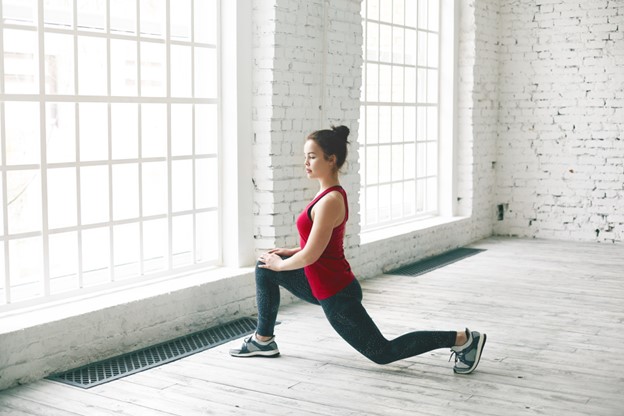
- Begin by standing up straight with your feet hip-width apart. Keep your core engaged and shoulders relaxed.
- Take a controlled step forward with one leg. Your stride should be long enough that when you bend your front knee, it forms a 90-degree angle.
- As you step forward, bend your front knee while keeping your back straight. Your back knee should hover just above the ground, almost touching it.
- Push off your front foot to return to the starting position. Engage your glutes and quads as you rise.
- Repeat the movement, this time leading with the opposite leg. This completes one rep.
Side Lunges
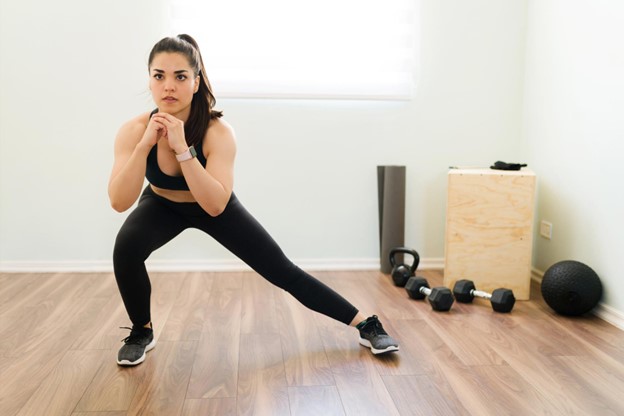
- Begin by standing up straight with your feet together. Maintain good posture with your chest up and shoulders relaxed.
- Choose one side to start with and take a lateral step to that side. Keep your toes pointed forward and your feet flat on the ground.
- As you step to the side, bend your knee, pushing your hips back and keeping your other leg straight. Your bent knee should create a 90-degree angle, and your weight should be on your heels.
- Push off the bent leg to return to the starting position. Keep your core engaged and ensure smooth, controlled movements.
- Alternate between both sides to work both legs evenly.
Cross-Over
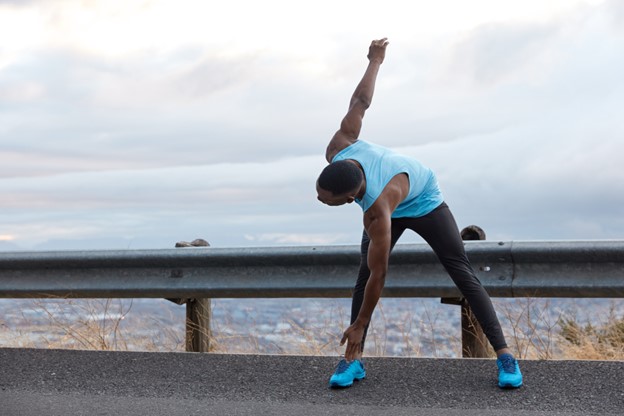
- Begin by standing tall with your feet hip-width apart. Maintain a straight posture, engaging your core.
- Lift one leg and cross it over your other leg. Ensure the leg you’re crossing over is fully extended.
- As your leg crosses over, gently touch the toes of your crossed leg to the ground on the opposite side. Keep your supporting leg slightly bent.
- Lift the crossed leg back to the starting position, uncrossing it. Keep your movements controlled and deliberate.
- Repeat the same steps with the opposite leg, crossing it over the other.
Standing Quad Stretch
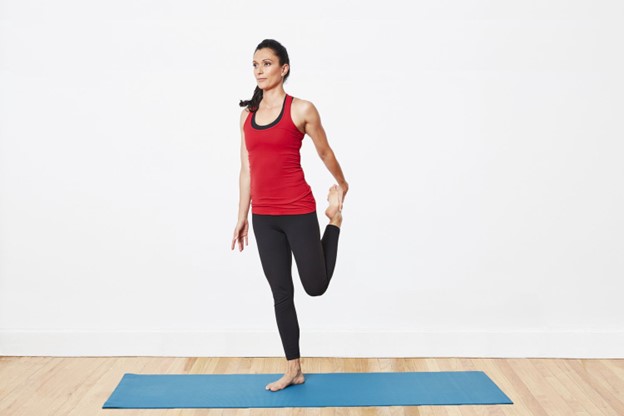
- Begin by standing upright with your feet hip-width apart. Maintain good posture with your shoulders relaxed.
- Shift your weight to one leg while keeping your core engaged for balance.
- Reach behind you with the hand on the same side as your supporting leg and grab your ankle.
- Gently pull your ankle towards your glutes. You should feel a stretch in the front of your thigh.
- Hold the stretch for about 20-30 seconds, breathing deeply and maintaining your balance.
- Release the stretch and switch to the other leg, repeating the same steps.
Seated Side Straddle

- Begin by sitting on the floor with your legs extended straight in front of you.
- Open your legs as wide as you comfortably can, forming a V shape.
- Keep your back straight, and engage your core muscles for stability.
- Lean to one side, bringing your chest toward your thigh while keeping both buttocks on the ground. Avoid rounding your back.
- Reach as far as you can while maintaining a comfortable stretch. Hold this position for 20-30 seconds, feeling the stretch along your inner thigh.
- Return to the center and repeat the stretch on the other side, leaning toward the opposite thigh.
Seated Stretch

- Begin by sitting on the floor with your legs extended straight in front of you. Sit tall, ensuring your back is straight, and engage your core muscles.
- Point your toes towards the ceiling, creating a slight stretch in your calf muscles.
- Slowly and gently lean forward from your hips, reaching toward your toes. Keep your back straight as you do this, and avoid rounding your spine.
- As you reach, you’ll feel a stretch in your hamstrings and lower back. Hold this position for 20-30 seconds, breathing deeply.
- Slowly release the stretch and return to the initial sitting position.
Knees to Chest

- Begin by lying flat on your back on a comfortable surface, such as a yoga mat.
- Slowly bring your knees toward your chest, allowing your lower back to gently round as you do so.
- Reach your arms around your knees and clasp your hands together, hugging your knees close to your chest.
- Point your toes upward and keep your feet flexed.
- Hold this position for 20-30 seconds, breathing deeply and relaxing into the stretch.
- Gently release your knees and return your feet to the starting position.
Standing Side Stretch
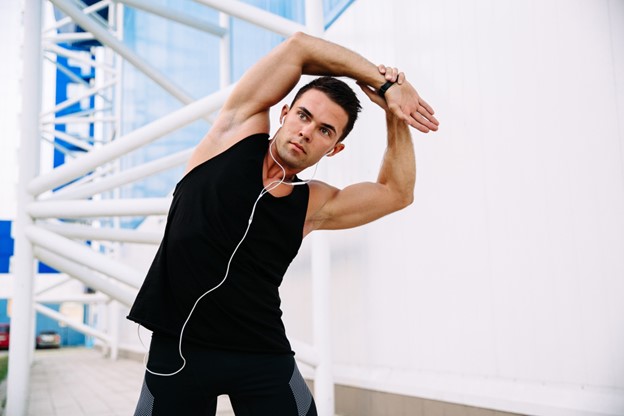
- Stand up tall with your feet hip-width apart. Keep your spine straight, and relax your shoulders.
- Raise your arms overhead and interlock your fingers, palms facing upward.
- While keeping your arms extended, gently lean to one side, creating a lateral stretch along your entire body.
- You should feel a deep stretch along your side, from your fingertips down to your hip. Keep your core engaged for balance.
- Hold the stretch for 20-30 seconds, taking deep breaths to allow your body to relax into the stretch.
- Slowly return to an upright position and repeat the stretch on the opposite side.
Seated Hamstring Stretch

- Sit on the floor with your legs extended straight in front of you. Keep your back straight, shoulders relaxed, and toes pointing upward.
- Tighten your abdominal muscles to stabilize your spine.
- Slowly and gently lean forward from your hips, reaching toward your toes. Keep your back straight as you do this, and avoid rounding your spine.
- You should feel a gentle stretch in your hamstrings. Remember to breathe deeply and relax into the stretch.
- Hold the position for 20-30 seconds, allowing your muscles to gradually release.
- Slowly release the stretch and return to an upright sitting position.
Standing Calf Stretch
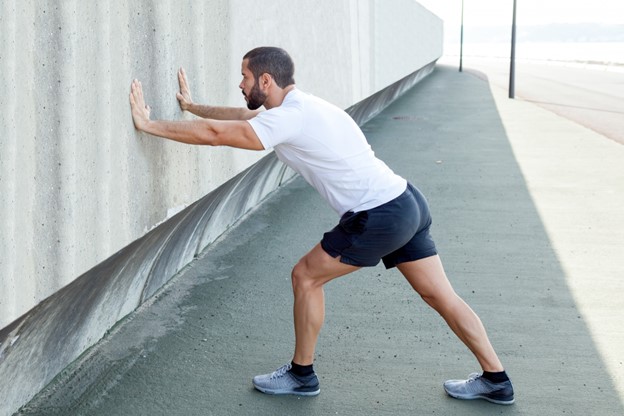
- Stand upright with your feet hip-width apart and keep your posture tall, shoulders relaxed.
- Take a step back with one foot, about half a stride length, keeping your toes pointing forward.
- Shift your body weight to your back leg while keeping the front leg slightly bent.
- Press your back heel firmly into the ground. You should feel a stretch in your calf muscle.
- Maintain this position for 20-30 seconds while breathing deeply and relaxing into the stretch.
- Release the stretch and switch to the other leg, repeating the same steps.
Shoulder Stretch
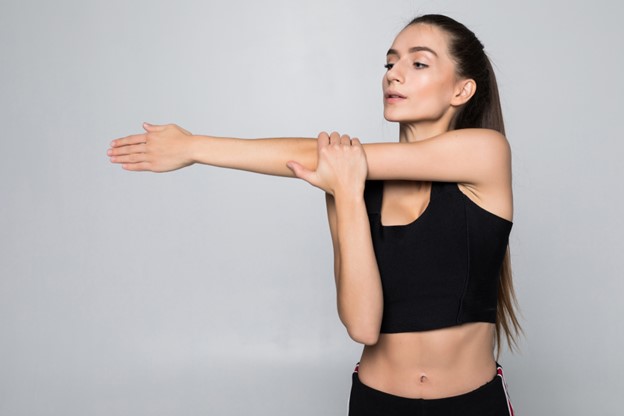
- Stand up straight with your feet shoulder-width apart. Maintain proper posture, keeping your core engaged and shoulders relaxed.
- Extend one arm straight across your chest at shoulder height.
- Use your opposite hand to gently press the extended arm towards your chest. You should feel a stretch in your shoulder and upper back.
- Maintain this position for 20-30 seconds, breathing deeply and focusing on relaxing into the stretch.
- Release the stretch and repeat the same steps with the opposite arm, bringing it across your chest.
The Forward Hang

- Begin by standing with your feet hip-width apart. Keep your spine straight and your shoulders relaxed.
- Step your feet slightly wider than hip-width apart.
- Raise your arms overhead and interlock your fingers with your palms facing upward.
- Slowly hinge at your hips, allowing your upper body to fold forward. Let your arms dangle towards the floor.
- Allow your head to hang freely, relaxing your neck and spine.
- Maintain this position for 20-30 seconds, breathing deeply and surrendering to the stretch.
- Slowly roll up, one vertebra at a time, until you’re standing upright again.
Back Stretch
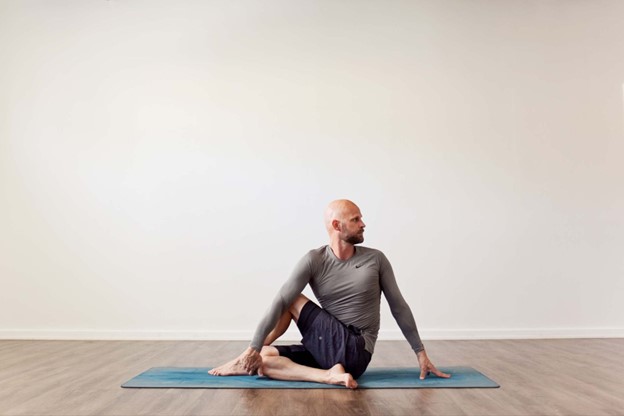
- Begin by sitting on the floor with your legs extended straight in front of you. Maintain a tall posture with your spine erect.
- Gently bend your knees and place your feet flat on the floor, keeping them hip-width apart.
- Cross your right leg over your left, placing your right foot beside your left knee.
- Rotate your upper body to the right, placing your left elbow on the outside of your right knee.
- Slowly twist your torso further to the right while looking over your right shoulder.
- Hold the stretch for 20-30 seconds, taking deep breaths and feeling the gentle twist in your spine.
- Release the stretch, uncross your legs, and switch to the opposite side, repeating the steps.
Butterfly Groin Stretch
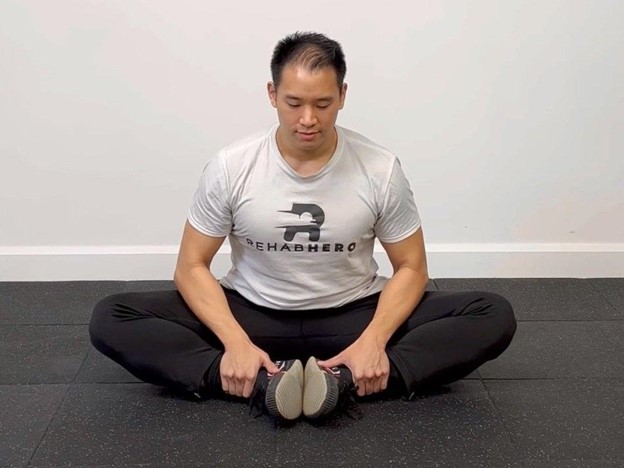
- Sit on the floor with a straight spine and your legs extended in front of you.
- Bend your knees and bring the soles of your feet together, allowing your knees to drop to the sides.
- Grasp your feet with your hands, interlocking your fingers if possible.
- Keep your back straight and your shoulders relaxed.
- Gently press your knees toward the floor while keeping your feet together.
- You should feel a stretch in your inner thighs and groin area.
- Maintain this position for 20-30 seconds while taking deep breaths and relaxing into the stretch.
Split Squat

- Stand tall with your feet hip-width apart and your hands on your hips.
- Take a step back with your right foot, positioning it behind you and keeping your toes pointing forward.
- As you lower your body into the squat, open your arms to the sides, resembling butterfly wings.
- Ensure that your front knee stays directly above your ankle as you lower yourself down.
- Hover your back knee just above the ground, maintaining a controlled movement.
- Push through your front heel to return to the starting position, bringing your arms back to your hips.
- Repeat the exercise with your left foot stepping back.
Modified Cobra

- Begin by lying face-down on a comfortable surface, such as a yoga mat or carpet.
- Keep your legs extended straight and together, with the tops of your feet resting on the ground.
- Place your palms on the ground directly under your shoulders, fingers pointing forward.
- Activate your core muscles to support your spine.
- Slowly and gently lift your upper body off the ground, using your back muscles. Keep your hips grounded.
- Roll your shoulders back and down, away from your ears, to open up your chest.
- Maintain the stretch for 20-30 seconds while taking deep breaths and feeling the gentle extension in your spine.
- Slowly lower your upper body back to the ground.
Conclusion
The Path to Sporting Success Through Flexibility
Flexibility isn’t a mere side quest; it’s a path to sporting success. By incorporating these flexibility-enhancing drills into your routine and embracing the mental and physical benefits, you’re poised to elevate your performance to new heights.
Final Thoughts and Encouragement to Get Started
The journey to improved flexibility begins with the first stretch. Armed with knowledge, determination, and the right drills, you’re ready to embark on this transformative path. Score big in your athletic pursuits, unlocking the athlete within you through the power of flexibility-enhancing drills.

